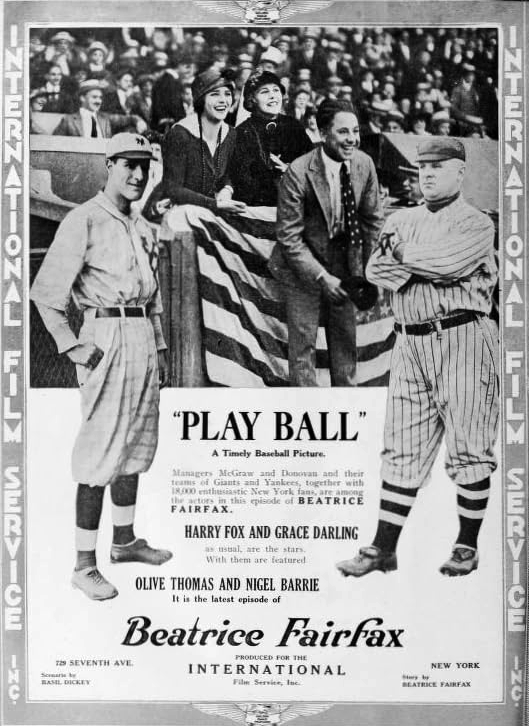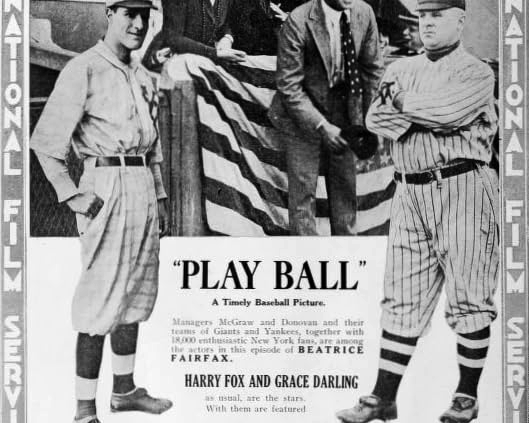September 10, 1916: Giants, Yankees play exhibition for Hollywood, charity
 Exhibition games involving major-league teams were once commonplace. Some were staged against other major-league clubs or minor-league or local league teams to warm up for the season or when passing through a specific location. Others were played at special events or as an attraction to draw in revenue for a business. Still others were played to raise money for a cause, such as the benefit game for the family of Addie Joss after the former major leaguer’s sudden death in 1911.
Exhibition games involving major-league teams were once commonplace. Some were staged against other major-league clubs or minor-league or local league teams to warm up for the season or when passing through a specific location. Others were played at special events or as an attraction to draw in revenue for a business. Still others were played to raise money for a cause, such as the benefit game for the family of Addie Joss after the former major leaguer’s sudden death in 1911.
On September 10, 1916, the New York Giants and New York Yankees played an exhibition game at the Polo Grounds, which had been both clubs’ home field ever since the Yankees signed a 10-year rental lease before the 1913 season. Even though New York’s blue laws banned Sunday baseball, the teams took to the diamond for their second Sunday exhibition in two seasons, following an Independence Day 1915 game that the New York Times had described as “a combination band concert, song recital, beauty show, and ball game, all for sweet charity’s sake.”1 This time, as pregame advertisements noted, “Receipts [were] to be devoted to the New York American Fund for Needy Families.”2
While this was distinctive in its own right, there was another noteworthy aspect: Hollywood’s cameras were present, filming a baseball-themed episode of a popular film serial.
Movies and baseball are no strangers. The sport has provided the backdrop and the focus of many cinematic classics such as Field of Dreams, Bull Durham, and the Major League franchise. But when was baseball first filmed? The honor goes to a 30- to 45-second clip titled The Ball Game, filmed in 1898 by the Edison Film Company.3
In 1916 Hollywood turned to the Giants-Yankees exhibition for scenes for Play Ball!,4 the 10th installment of the Beatrice Fairfax film serial, starring Grace Darling, that had debuted in August 1916. Film serials were a collection of short films that were part of a series, comparable to sitcom episodes. Each week or at some specified time interval, the newest installment of a serial was shown in a movie theater along with a feature film. To follow the series, the patron would have to return to the cinema for each new installment, providing theater owners with a steady revenue stream.
The players and fans at the Polo Grounds were filmed to be included in Play Ball!, which was the first film appearance of 21-year-old Olive Thomas, soon to be one of early Hollywood’s most famous ingénues. Thomas, known as “Everybody’s Sweetheart,” went on to become one of the biggest stars in Hollywood before meeting an untimely death in a Paris hotel room at age 25 in 1920 when she ingested mercury bichloride mixed with alcohol, which she allegedly mistook for a sleeping potion.5
Play Ball!’s plot revolved around a professional gambler and saloonkeeper, Martin O’Day (played by Bruce McRae), who bets big on manager Bill Donovan and the Yankees to beat John McGraw and the Giants. O’Day planned on kidnapping fictional Giants star pitcher Bert Kerrigan (played by Nigel Barrie). From there the plot twisted and turned until Kerrigan, with the help of Beatrice and friends, escaped his captors and saved the day by entering the game just in the nick of time to help the Giants defeat the Yankees. McGraw, Donovan, and their teams, along with 17,000 to 18,000 fans, became part of the show.6
The afternoon began with a concert by Nahan Franke’s Band and solos by Miss Anna Fitzjui and Hugh Allen of the Metropolitan Opera Company. Then, according to the St. Louis Star, “Before the regular game started, the members of the two teams enacted the critical stage of the film game, with the movie actors in the characters they appear in the episode.”7 The article added, “The vast crowd was then photographed from all sides. Many scenes of the regular game will form part of the photo-play.”8
The exhibition game itself began at 2:30 P.M. A day earlier at the Polo Grounds, the Giants had swept the Philadelphia Phillies in a doubleheader, thanks to two complete-game wins by pitcher Pol Perritt, giving them a modest four-game winning streak. The sweep had knocked the Phillies out of a tie with the Brooklyn Robins for first place in the National League. The Giants were in fourth place, 12½ games behind the Robins. The Yankees – still looking for their first-ever American League pennant – had been in first place for most of July, but they had faded to fourth, seven games in back of the Boston Red Sox.
According to the New York Sun, “Prior to the game many fans expected little more than an exhibition, but they evidently reckoned not upon the performers. Play after play of spectacular brilliance was enacted. From the recklessness of the attack and defense one might have thought there was more at stake than just fall suits of cloths for the winning team.”9
The game featured such notables as Buck Herzog, Benny Kauff, George Burns, and Heinie Zimmerman suiting up for the Giants. On the opposite bench, Lee Magee, Paddy Baumann, Roxy Walters, Elmer Miller, and the rest of the Yankee squad readied themselves for a battle.
The game was played with a fierce intensity. Second baseman Herzog received a nasty cut to his left leg courtesy of Miller’s spikes as he made a sweeping tag to complete a double play in the second inning. Later, in the eighth, Dave Robertson of the Giants was hit in the knee with a pitched ball. The New York Sun reported that he “dropped to the ground as if shot.”10
Ferdie Schupp, the Giants’ winning pitcher on September 7, the first game of the winning streak, started out pitching against the Yankees’ Allen Russell. The game’s highlight was a second-inning home run by Kauff, who sent the ball into deep right-center. As the New York Times wrote, “The retiring Bennie Kauff was forced into the limelight as the shining figure in the victory of the Giants.”11
The Giants added a run in the third when Burns singled, took third on Herzog’s hit-and-run single, and scored when Yankees catcher Roxy Walters threw the ball away on a double steal.12
The Yankees got on the scoreboard in the top of the fourth. They loaded the bases against Schupp, and McGraw brought in Fred Anderson in relief with a two-ball count on Russell. Anderson threw two more balls to force in Baumann with a walk.13
Donovan’s club tied it up in the sixth. Miller walked and stole second. Walters drove him in with a double to center, a hit that the New York American reported “might have been a home run had not Kauff knocked the ball down with his meat hand.”14
But the Giants pulled ahead, thanks to Zimmerman, who had come to New York on August 28 in a five-player deal that sent Larry Doyle to the Chicago Cubs. In the bottom of the sixth, Zimmerman beat out an infield single, stole second, and scored on Art Fletcher’s double. The game’s final run was scored in the eighth when Burns doubled, Herzog bunted him to second, and Zimmerman’s fly ball brought him home.15
In the end, the Giants walked away with a 4-2 victory – though it could be stated that the day’s true winners were the recipients of $11,500 ($331,469.04 in 2024) collected for the charity.
After the day off from league play, McGraw’s club went on to win their next 22 games – interrupted only by a tie against the Pittsburgh Pirates on September 16 – for a major-league-record 26-game winning streak. Despite the winning streak, the Giants came in fourth in the NL, trailing Brooklyn by seven games.16 The Yankees also finished fourth, 11 games behind the World Series champion Red Sox. When the two clubs next met at the Polo Grounds, half a decade after Hollywood had filmed their 1916 exhibition, the stakes were considerably higher: it was Game One of the 1921 World Series.
Acknowledgments
This article was fact-checked by Mike Huber and copy-edited by Len Levin.
Photo credit: Play Ball! film publicity poster, 1916, from IMDB.com.
Sources
In addition to the sources cited in the Notes, the author consulted Baseball-Reference.com and Retrosheet.org for pertinent information.
Notes
1 “Giants Beat Yanks at Benefit Game,” New York Times, July 5, 1915: 8.
2 “Polo Grounds Today: Giants vs. Yankees,” New York Times, September 10, 1916: Sports, 3. Some coverage also suggested that there was a charitable purpose to benefit families of National Guardsmen stationed along the Mexican border to prevent further raids and attacks by Pancho Villa. “Movie Star and Pitcher Center of Attraction at Benefit Game,” Muncie (Indiana) Press, September 14, 1916: 6; “Benefit the 69th,” New York Times, September 17, 1916: 14.
3 John Thorn, “Early Baseball Film,” Medium.com, August 22, 2022, https://ourgame.mlblogs.com/early-baseball-film-3ffab5c6d24a.
4 “Beatrice Fairfax Episode 10: Play Ball!,” IMDB.com, https://www.imdb.com/title/tt0201455/, accessed September 2024; “High Lights and Extraordinary Opinions,” Sporting Life, September 23, 1916: 3.
5 “Poisonings Throughout History: Olive Thomas,” eAntidote, August 31, 2023, https://blog.mdpoison.com/2023/08/poisonings-throughout-history-olive-thomas/.
6 ‘Giants and Yankees Pose for ‘Miss Fairfax,’” St. Louis Star, September 11, 1916: 13; “Giants Trounce Yankees by 4 to 2 in Charity Game,” New York Sun, September 11, 1916: 10.
7 “Great Picture at Polo Park,” El Paso Herald, September 11, 1916: 9; “Giants and Yankees Pose for ‘Miss Fairfax.’”
8 “Giants and Yankees Pose For ‘Miss Fairfax.’” The remainder of the serial was shot at the Wharton studio, located on the southern end of Cayuga Lake in Ithaca, New York in Renwick Park (now known as Stewart Park). “Stewart Park,” City of Ithaca – New York, https://www.cityofithaca.org/516/Stewart-Park. Accessed September 2024.
9 “Giants Trounce Yankees by 4 to 2 in Charity Game.”
10 “Giants Trounce Yankees by 4 to 2 in Charity Game.”
11 “Giants Win for Movies,” New York Times, September 11, 1916: 10.
12 Damon Runyon, “Giants Defeat Yanks; Needy Get $11,000,” New York American, September 11, 1916: 7.
13 Runyon.
14 Runyon.
15 “Giants Trounce Yankees by 4 to 2 in Charity Game.”
16 The Giants had not been higher than fourth place in the NL standings since June, even with the record 26-game win streak in September.
Additional Stats
New York Giants 4
New York Yankees 2
Polo Grounds
New York, NY
Corrections? Additions?
If you can help us improve this game story, contact us.


